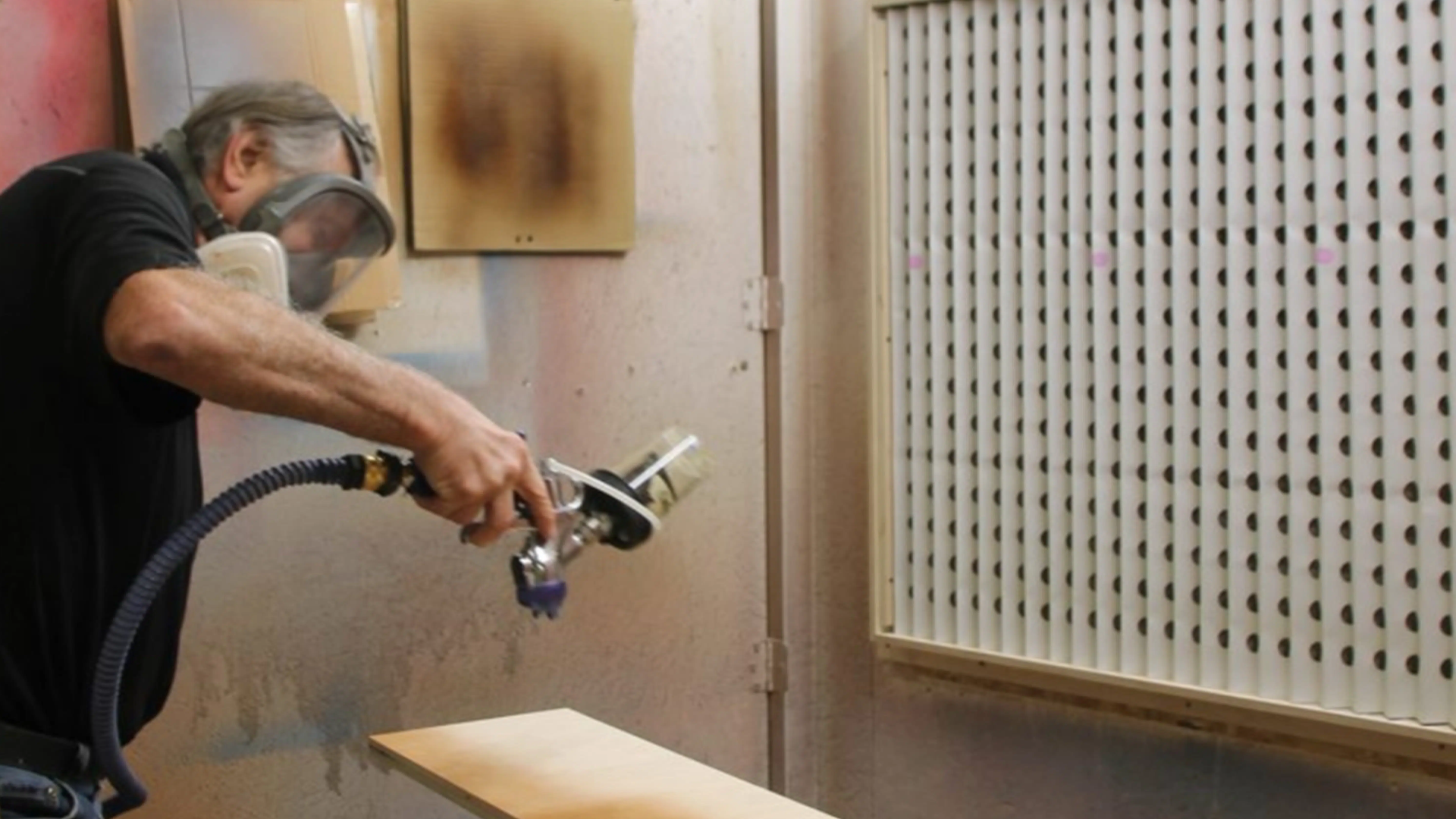
Adding 3M™ PPS™ to your Spray Gun: What’s up with That?
Like so many, I’m always looking for ways to improve my efficiency and save money, while still maintaining the highest possible finish quality. So imagine the excitement I felt when speaking with some of my associates who’d taken the plunge to 3M™ Paint Preparation System (PPS™), telling me they aren’t looking back. Why, I just had to get my hands on it and see for myself “what’s up with 3M™ PPS™”!
In this article I’ll explain what the 3M™ PPS™ system is and how it works. And because I’ve been using it with all my spray systems – turbine and compressor based – while spraying everything from shellac to latex paint over the past few months, what follows is based on hands-on experience. Let’s see how things went.
About the 3M™ PPS™ System
First off, PPS™ stands for “Paint Preparation System” and it’s been around for nearly 20 years. The initial system, which 3M™ now calls “Legacy”, has seen several improvements since its inception. Series 2.0, which is their latest version, is available in two variants: one for turbine spray guns and the other for compressor spray guns.
How it Works

Filling the PPS cup with finish™
At the heart of the system is the mixing cup with its flexible, disposable liner which holds the finish. To use the system, you drop a liner into the cup, pour in the desired amount of finish and screw on the lid finger tight. Torque too much and will cause leaks. Then go ahead and invert your spray gun and mate it to the cup; a quarter turn and you’re there. Hook up your air hose (and pressure line if it’s a turbine gun), invert the spray gun and squeeze the trigger until all the air has been exhausted from the cup and finish starts coming out. Your gun is now ready to use.
Once your spray session is over, disconnect the gun from the air hose, invert the gun and squeeze the trigger for a few seconds to allow the liner to return to its original position. Then tap the still inverted gun a few times to your bench to encourage most of the finish to flow back into the cup, then release the trigger. Go ahead and unscrew the gun from the cup.
Pros and Cons
Now that you have a general idea how the system works, let’s take a look at both the pros and cons of PPS™, beginning first with the advantages.
All Angle Spraying
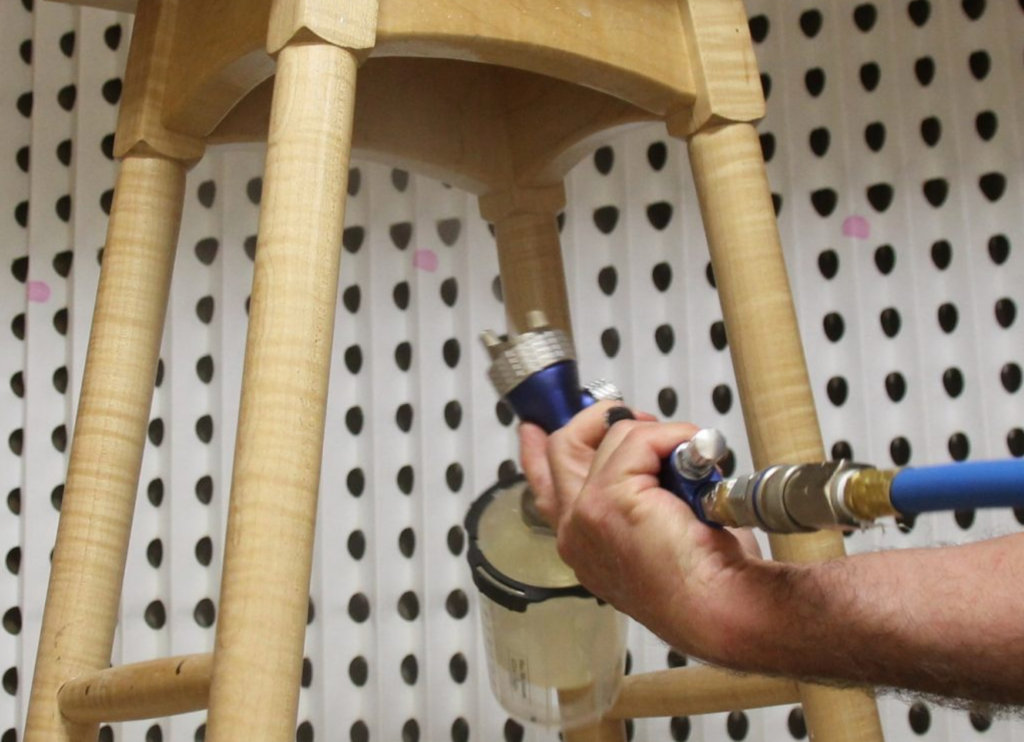
Spraying underside of a stool made simple with PPS™
As someone specializing in furniture making, I’m always having to spray at awkward angles, and frequently, inside confined spaces. And this is one very important advantage which PPS™ provides: you can spray at any angle you wish, even upside down without ever having to worry about your spray gun being starved of finish and sputtering.
No Straining or Filtering Necessary
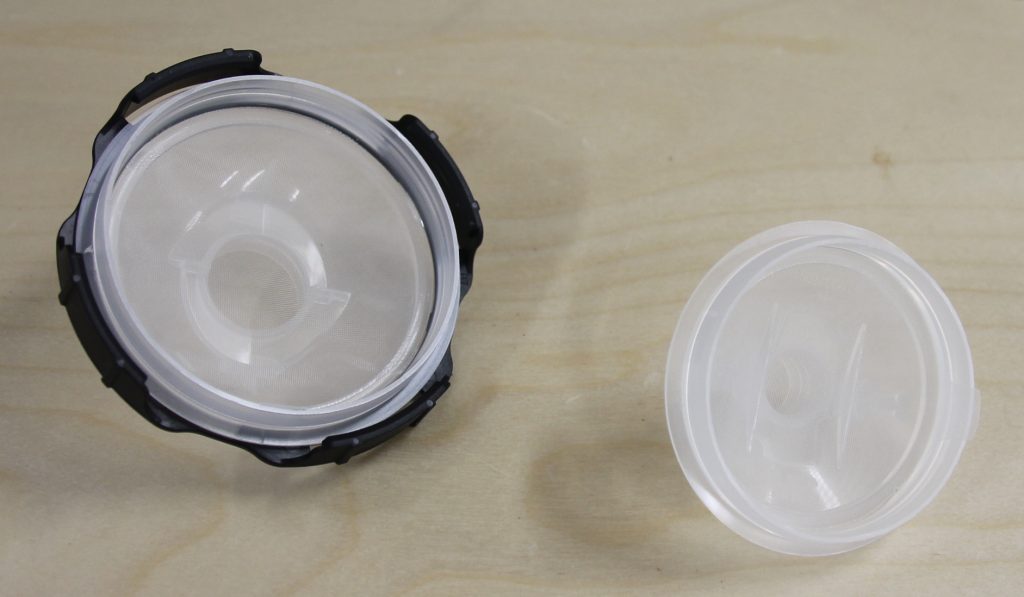
Built-in mesh strainer on every lid
In many ways, this is the most important advantage PPS™ provides. Not only does it save you time, but gone are the days of having to deal with bits of dried finish or contaminants from the tin clogging your spray gun or landing on and ruining an otherwise perfect coat. And you have your choice of two strainer mesh sizes: 200 or 150 micron, which gives you all sorts of flexibility in using various finishes.
Measure Right in the Cup

Gradations facilitate measuring finish
For those of you who frequently spray multi-part finishes or need to thin finishes often, you’ll be happy to learn that you can measure your finishes right in the cup. This saves the requirement to clean your measuring cup, which can make your life that much easier.
Notice that the H/O cup (on the left) has a reversible sleeve with the gradations marked on it, unlike the the regular 2.0 series cup which has them embossed on it.
Simplified Clean-Up

Mate a cup filled with solvent and you’re ready to efficiently perform a simple spray gun cleaning
This is another important advantage of PPS™. With the cup out of the way and most of the finish drained from the gun, doing a simple (what I call Level I) cleaning is greatly simplified. All that’s needed is to flush out your gun using whatever solvent is called for, (in my case it’s usually plain old tap water because I spray mostly water-based finishes) then a quick wipe of the air cap with a solvent-dampened rag (again, water-dampened in my case) and you’re done. To make this even easier, I keep on hand a spare PPS™ cup filled with solvent (again, tap water in my case) which I connect to my spray gun then spray until only solvent is coming out. Cleaning just doesn’t get any simpler than that!
Storing Leftover Finish is Improved
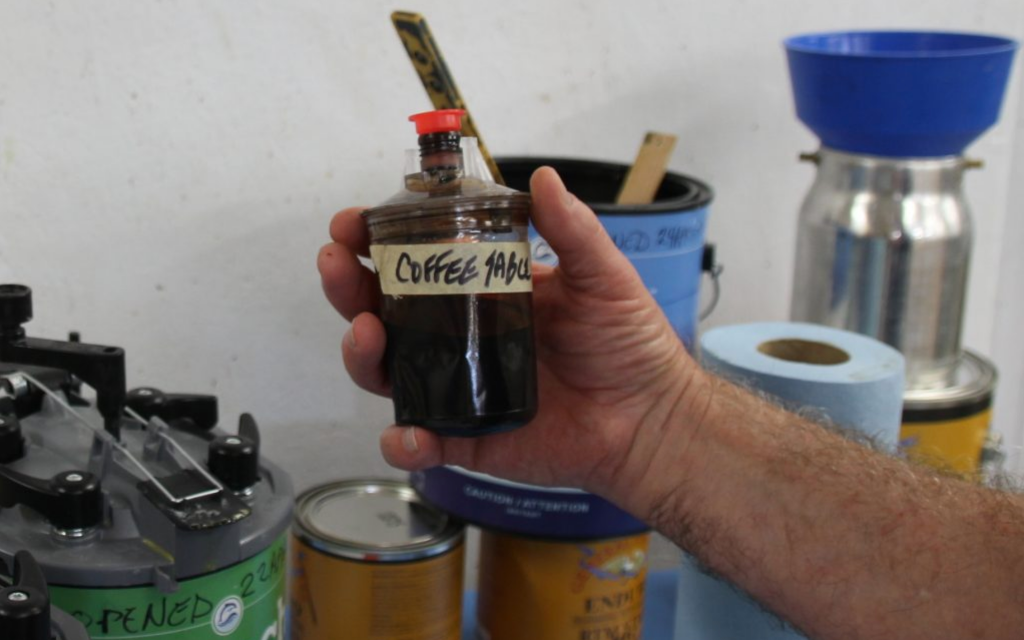
Storing finishes directly in the cup liner
If you thought that the aforementioned advantages of PPS™ were something to write home about, you’ve not seen it all. Storing leftover finish is as easy as capping off the PPS™ lid. And if you purge most of the air from the liner as you insert the plug, leftover finish will last longer stored this way than if you were to pour it back into the tin.
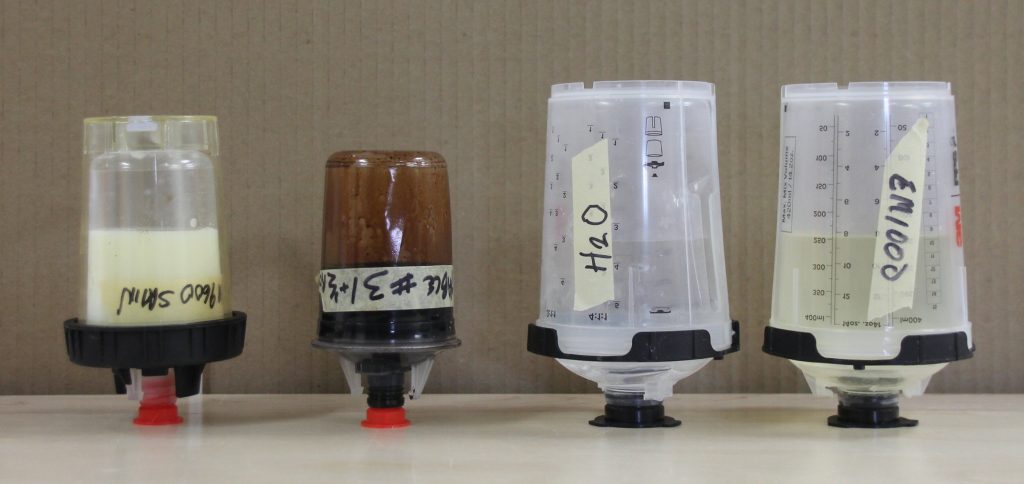
Store cups upside down to keep the filter from drying out and causing clogging
Compressor & Turbine Powered Spray Guns Accommodated
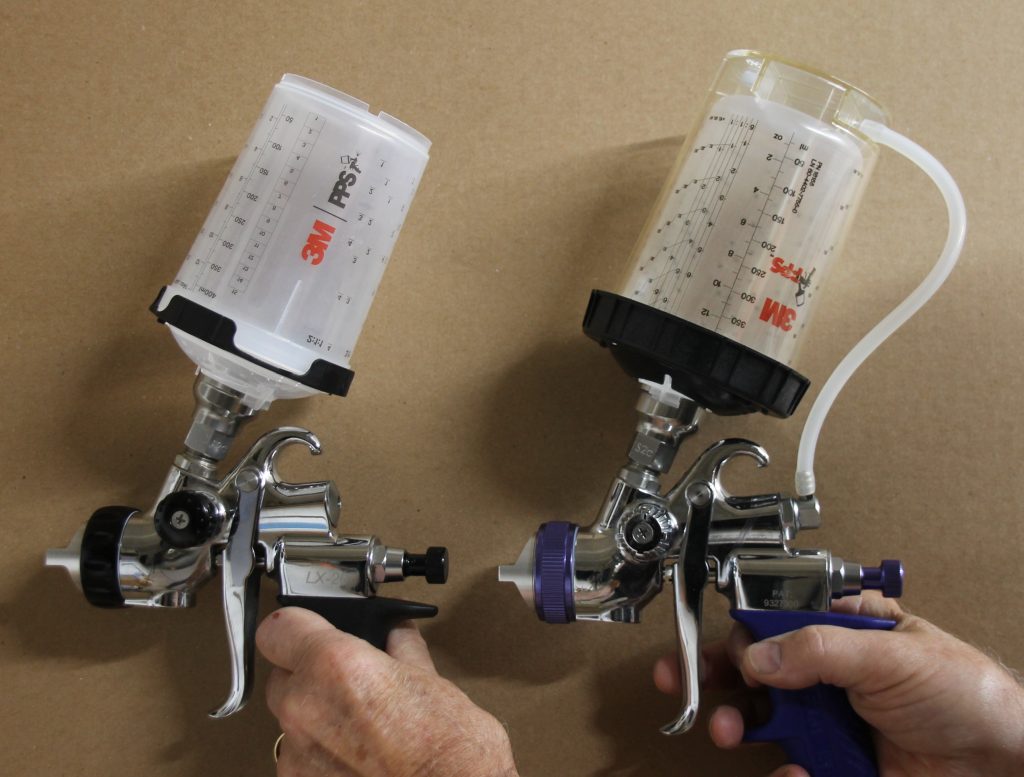
Marty’s LX-20 compressor gun (L) and T75G turbine gun (R)
Because I own several different compressor and turbine powered spray guns, I was happy to hear that all of the various styles of spray guns – gravity as well as bottom feed cup ones – could be outfitted with PPS™.
How 3M™ accommodated them was both simple and elegant: they created a lightweight cup for compressor powered systems and, what the call their H/O (High Output) cup with its unique collar, for turbine powered ones. Everything else about the two is the same and both systems perform identically well.
Different Jobs? Different Cup Sizes!
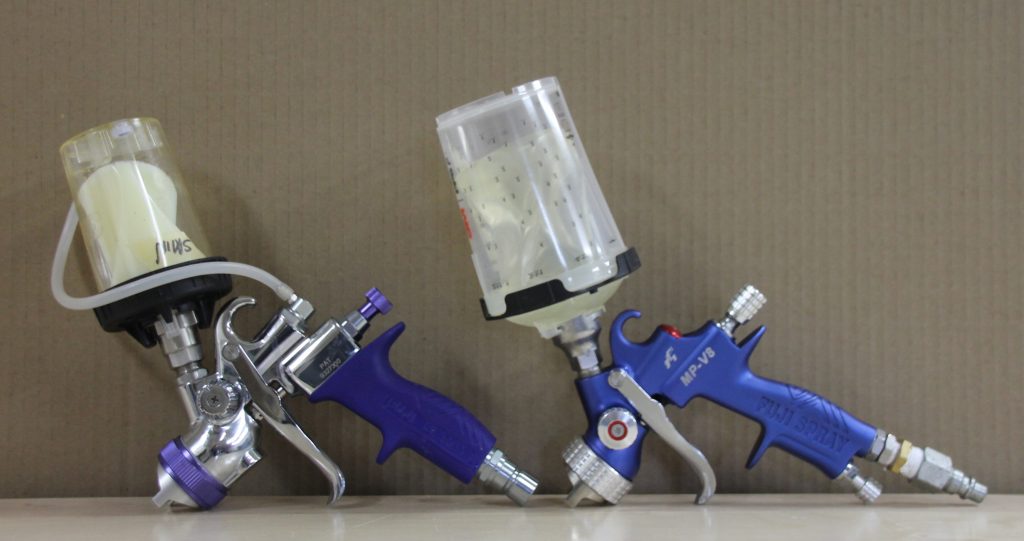
Mini up fitted to T75G turbine HVLP spray gun (L); Standard cup fitted to MP-V8 compressor spray gun (R)
Another great feature that 3M™ has provided the system is different sized cups. Their larger lid accommodates their “Large” 850ml (28oz) and “Standard” 650ml (22oz) cups, and their smaller lid handles “Midi” 400ml (13.5oz), “Mini” 200ml (6.8oz) and “Micro” 90ml (3oz) cups, so there’s a size for nearly every job imaginable.
Environmentally Friendly
For those of you who use solvent-based finishes, the PPS™ system is much better for the environment because less cleaning solvent is required. However, for those of us who’ve moved over to water-based finishes and therefore use solvents only when absolutely necessary, that point is not quite as important.
Labour Savings
From my experience, there is no arguing that using PPS™ will certainly save you time on the job. It not only makes for quick and efficient swapping between finishes but significantly enhances spraying all parts of cabinetry and projects because of its all-angle spraying capability. And when it comes time to clean your spray gun, it enables you to do so more quickly and easily. Time is such a very important consideration for all of us – whether you’re doing this for a living or as a hobby. And to me that’s a very significant advantage which PPS™ provides.
Let’s Look at the Flip Side
So much for the advantages. Let’s now take a look at what I consider to be the one and only disadvantage of 3M™ PPS™.
Disposable Cup Liners and Lids
No doubt about it, if you consider only the cost of disposable cup liners and lids, PPS™ is more expensive to use than a standard cup. However, one has to give 3M™ points for the relative durability of the cup liners which allows them to be reused, time and again. I average six reuses for each liner, and double that for the lids, which brings the unit cost down quite considerably. Perhaps a purist would look at this differently.
Summary
I’ve got to say that after having used the PPS™ system with a variety of both turbine and compressor system spray guns, applying a broad variety of finishes over the past few months, I’m highly impressed. With its multitude of advantages and only one disadvantage, I wholeheartedly endorse and recommend 3M™ PPS™ to anyone, and especially to those who spray finishes professionally.
As always, I would very much appreciate receiving your comments and perspectives on this topic.
All the best with your spray finishing!
Marty Schlosser


